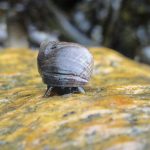 The winkle is a small, edible snail, one usually poached and then eaten with bread and butter. Its name, first recorded in the mid sixteenth century, is short for periwinkle, which dates back another fifty years to the early sixteenth century. Periwinkle in turn derives from the Old English pinewinde, meaning shellfish, formed by combining the Latin pina, the name of a species of mussel, with the Old English wincle, meaning winch; the name was inspired by the resemblance of the snail’s spiralling shell to a winch, a large spool used to reel in rope or chain. Also related to the Old English wincle is the word wink, the connection being that when you wink, your eyelid “curves” over your eye like an arc in a spiral. Periwinkle, incidentally, is also the name of a trailing plant better known as myrtle; this periwinkle, however, probably derives its name from the Latin per vincire, meaning to bind thoroughly, a name prompted by the plant’s ability to extend itself over a large area and stubbornly resist removal.
The winkle is a small, edible snail, one usually poached and then eaten with bread and butter. Its name, first recorded in the mid sixteenth century, is short for periwinkle, which dates back another fifty years to the early sixteenth century. Periwinkle in turn derives from the Old English pinewinde, meaning shellfish, formed by combining the Latin pina, the name of a species of mussel, with the Old English wincle, meaning winch; the name was inspired by the resemblance of the snail’s spiralling shell to a winch, a large spool used to reel in rope or chain. Also related to the Old English wincle is the word wink, the connection being that when you wink, your eyelid “curves” over your eye like an arc in a spiral. Periwinkle, incidentally, is also the name of a trailing plant better known as myrtle; this periwinkle, however, probably derives its name from the Latin per vincire, meaning to bind thoroughly, a name prompted by the plant’s ability to extend itself over a large area and stubbornly resist removal.
The periwinkle, a diminutive marine snail adorned in an ebony hue, captures our attention. When venturing to prepare these intriguing creatures, it is essential to commence by subjecting them to a thorough cleansing ritual, ensuring their pristine state by immersing them in multiple rinses of water to expel any traces of sand. Subsequently, they are poised to undergo a transformative process, delicately boiled in salted water for a duration of 20 minutes. While periwinkles can be found along the coastal regions spanning from Nova Scotia to New Jersey, it is worth noting that they do not command the same level of appreciation and popularity in North America as they do within the realms of Great Britain and Europe.
